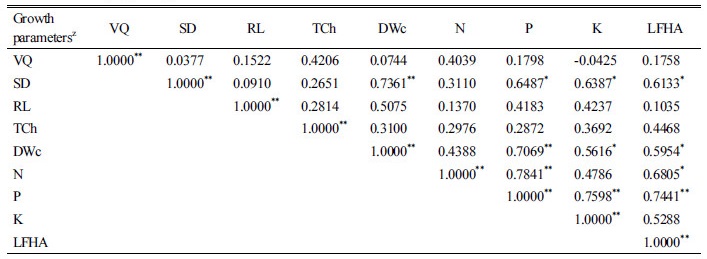서 론
부식물질은 일반적으로 pH의 용해여부에 따라 휴믹산(humic acid), 풀빅산(fulvic acid) 및 휴민(humin)으로 분류되고(MacCarthy et al., 1985), 토양구조, 양이온치환용량(cation exchangeable
capacity; CEC) 및 미생물 활성도 등을 개선하여 식물의 지상부와 지하부의 생육, 종자발아, 유묘 활착 등을 촉진하는 것으로 알려져 있다(Hamza and Suggars, 2001). 토양의 물리화학적 특성뿐 아니라 식물의 생리학적 과정에서 영향을 미치는(Cacco and Dell’Agnola, 1984) 부식물질은 처리농도에 따라 식물의 생육을 촉진하거나 저해하여 식물호르몬 처리와 유사한 특성을 보였으나 부식물질 중에서 식물호르몬은 확인되지 않았다(Cacco and Dell’Agnola, 1984). 부식물질 중 수용성 물질인 부식산은 식물의 지하부 생육과 양분 흡수 및 생육이 증가하는 것으로 알려져 있어 기능성 비료의 원료로 이용되고 있다(Jannin et al., 2012). El-Ghamry et al. (2009)는 아미노산을 부식산과 함께 처리할 경우에 양분 이용율이 증가하고, 병해 발생이 감소하여 작물의 생육이 건전해지므로 농자재 사용을 줄일 수 있다고 보고하였다.
Zhnag and Ervin (2004)은 부식산을 처리한 크리핑 벤트그래스(Agrostis palustris Huds.)에서 잔디품질, 지하부 생육, 엽록소지수 및 건조 스트레스에 대한 저항성 등이 증가한다고 보고하였다. 크리핑 벤트그래스에서 수용성 부식산의 처리는 잔디의 뿌리생육이 발달하여 토양유기물이용과 양분 흡수 및 수분흡수가 증가함으로써 광합성, 잔디생육, 잔디품질 등이 향상된다(Liu and Cooper, 2000; Hunter and Anders, 2004; Van Dyke et al., 2009). 이 외에도 부식산 처리는 잔디의 내건성이 증가하며(Hunter and Anders, 2004), 특히 식물호르몬이 함유된 부식물질인 해조추출물과 혼합하여 처리하는 경우 잔디생육과 품질 및 내건성 등에서 상승효과가 나타났다(Zhnag and Ervin, 2004).
국내의 잔디재배에서 부식산에 대한 연구는 입상이나 분말의 부식산을 이용하여 모래와 혼합하였을 때, 모래상토의 이화학적 특성 변화(Kim et al., 2010)와 이들 토양에서의 잔디생육 및 잔디품질의 변화에 대한 연구가 진행되어 왔다(Kweon et al., 2005; Lee et al., 2013; Kim, 2015). 그러나, 토양에 처리된 부식산은 토양개량제의 특성 상 쉽게 분해되지 않는 휴민으로 되어 있어 수용성 부식산 함량은 매우 적다(Lee et al., 2017). 최근 수용성 부식산을 함유한 다양한 기능성 비료들이 골프장에서 이용되고 있으나 기능성 비료 중 부식산의 함량 및 시비량에 대한 연구나 부식산 처리에 의한 잔디의 생육 및 품질의 변화에 대한 연구가 부족한 실정이다.
따라서 본 연구는 부식산과 복합비료가 혼합하여 액상으로 제형화된 부식산 함유 액비를 크리핑 벤트그래스에 시비하였을 때, 잔디의 생육과 품질에 미치는 영향에 대해 조사하고자 수행되었다.
재료 및 방법
시험기간 및 공시재료
본 연구는 2014년 7월부터 2014년 11월까지 5개월 동안 대전광역시 소재의 사이언스대덕 골프클럽 퍼팅그린에서 수행되었다. 공시잔디는 1997년 파종되어 약 17년간 관리된 크리핑 벤트그래스 ‘Penncross’ 품종을 이용하였다. 시험 포장의 토양은 USGA 규격에 적합한 모래와 코코피트가 각각 95%와 5%씩 부피로 혼합된 모래로 조성되어 있었고, 상토층의 깊이는 약 30 cm였다. 시험 전 토양은 pH와 EC가 각각 7.2와 0.21 dS m-1로 잔디재배가 가능한 토양이었다(Table 1). 잔디 생육에 필요한 양분을 공급하기 위해 공시비료는 복합비료(compound fertilizer: N-P2O5-K2O=18-2-18, (주)솔그린, 대전, 한국)와 부식산 함유 액비(liquid fertilizer containing humic acid (LFHA): N-P2O5-K2O-Cu-Zn=5-2-4-0.05-0.05, 효성오앤비(주), 충남, 한국)를 사용하였다. 부식산 함유 액비(LFHA)는 갈탄에서 추출한 부식산(5% 부식산)원료가 40% 함유되어 있었고, 비료의 종류는 제4종 복합비료였다.
처리구 설정
처리구는 비료의 종류 및 시비량에 따라 대조구[control fertilizer (CF); N-P2O5-K2O=18-2-18], LFHA를 1,000배 희석한 처리구1 (HA-1; CF+LFHA), 500배 희석한 처리구2 (HA-2; CF+2LFHA) 및 250배 희석한 처리구3 (HA-3; CF+4LFHA) 으로 구분하였다.
실험 포장의 실험구 단위는 1 m2 (1m×1m)크기로 전체 포장은 12 m2였고, 실험구 배치는 난괴법(3반복)으로 배치하였다. 공시비료 중 복합비료는 2014년 7월 4일과 8월 4일에 질소순성분량 기준으로 2.0 g N ai. m-2씩, 9월 4일과 10월 7일 및 11월 4일에 3.0 g N ai. m-2씩 각각 2회와 3회씩 총 5회 시비하였다. LFHA는 2014년 7월 4일, 7월 16일, 7월 25일, 8월 11일, 8월 26일, 9월 10일, 9월 25일, 10월 7일, 10월 22일, 11월 16일에 HA-1 (1.0 ml m-2 LFHA), HA-2 (2.0 ml m-2 LFHA) 및 HA-3 (4.0 ml m-2 LFHA)를 1,000 ml의 수돗물에 희석하여 총 10회 관주시비(희석액 1,000 ml m-2)하였다. 시험기간 중 예초 관리는 자주식 그린모어(GM262B-AC9, SIBAURA, Tokyo, Japan)로 주 2-3회 4.0 mm 높이로 실시하였다. 시험 기간 중 통기 작업은 9월 4일과 10월 6일 2회 실시하였고, 배토는 7월 30일, 8월 11일, 9월 4일, 10월 6일에 2-3 mm 두께로 총 4회 수행하였다. 병충해 방제를 위해 살균제인 프로피코나졸(propiconazole) 유제(2회, 8월 20일, 9월 20일)와 테부코나졸(tebuconazole) 유제(1회, 9월 30일)를, 살충제인 페니트로치온(fenitrothion) 유제(1회, 9월 10일)와 클로르피리포스메틸(chlorpyrifos-methyl) 유제(1회, 9월 30일)를 각각 살포하였다.
생육 조사 및 분석 방법
잔디 생육 조사는 처리구별 잔디의 가시적 품질(visual quality), 엽록소 함량, 뿌리 길이 및 예지물 등을 조사하였다. 잔디의 가시적 품질은 National Turfgrass Evaluation Program (NTEP)에서 제시한 방법에 준하여 7월 4일, 7월 16일, 7월 25일, 8월 11일, 8월 26일, 9월 10일, 9월 25일, 10월 7일, 10월 22일, 10월 30일, 11월 16일, 11월 27일에 총 12회 조사하였다(1=worst, 9=best and 6=acceptable). 잔디의 생육을 평가하기 위해 7월 25일, 8월 29일, 9월 30일, 10월 31일에 잔디예지물을 총 5회 조사하였고, 이 때 채취된 시료를 이용하여 엽록소 함량을 분석하였다. 잔디예지물은 예고가 4 mm로 셋팅된 자주식 그린모어를 이용하여 채취한 시료를 이물질을 제거한 후 70°C 드라이오븐(JSON-150, JSR, 공주, 한국)에서 24시간 건조하여 건물중을 측정하였다(NIAST, 1998). 잔디의 엽록소 함량의 측정은 잔디시료 0.1 g 를 10 ml DMSO (dimethysulfoxide)로 냉암소에서 48 시간 추출하여 UV-spectrophotometer (X-MA 1200, Human, 서울, 한국)를 사용하여 645 nm와 663 nm에서 흡광도를 측정하고, 아래와 같은 식으로 엽록소 a와 b 및 총 엽록소 함량을 계산하였다(Arnon, 1949).
Chlorophyll a=12.7 A663-2.69A645
Chlorophyll b=22.9 A645-4.68A663
Total Chlorophyll (a+b)=20.21 A645+8.02A663
잔디의 뿌리길이는 제작한 코어(지름 4 cm, 깊이 15 cm)를 이용하여 8월 11일과 10월 22일 2회 조사하였고, 잔디 밀도는 제작한 밀도측정용 코어(1 cm×1 cm)를 이용하여 9월 10일과 11월 27일 2회 조사하였다.
포장시험에서 공시비료 처리에 의한 토양의 변화를 조사하기 위해 시험 전(7월 4일)과 시험 종료 후(11월 27일) 총 2회 실시하였다. 토양시료는 자체 제작된 토양시료채취용 코어(지름 2 cm, 깊이 10 cm)를 이용하여 각 처리구별 4개씩 토양시료를 채취하였고, 분석을 위해 음지에서 풍건하였다. 분석 항목은 pH, 전기전도도(electrical conductivity; EC), 유기물(organic matter; O.M) 함량, 전질소(total nitrogen; T-N), 유효 인산(available phosphate; Av-P2O5)및 치환성 칼륨(exchangeable potassium; Ex-K) 등 이었고, 분석 방법은 토양 화학 분석법(NIAST, 1998)에 준하여 실시하였다. pH와 EC는 1:5법으로, O.M은 Tyurin법으로, T-N은 Kjeldahl 증류법으로, Av-P2O5는 Bray No.1법으로, 치환성 칼륨은 1N-NH4OAc 침출법으로 각각 분석하였다.
식물체 분석은 잔디예지물을 마지막으로 채취한 시료(10월 31일 시료)를 분석시료로 이용하였다. 분석 영양소는 잔디 생육의 주요 구성성분인 질소, 인 및 칼륨 등을 포함하였다. 잔디 식물체 분석은 식물체 분석법(NIAST, 1998)에 준하여 실시하였고, 질소는 Kjeldahl 증류법으로, 인은 UV-spectrophotometer (X-MA 1200, Human, 서울, 한국)를 이용하여 바나도몰리브덴산법으로, 칼륨은 염광광도계(flame photometer; PFP7, JENWAY, Staffordshire, UK)를 이용하여 각각 분석하였다.
통계처리는 SPSS 12.1.1을 이용하여 Duncan 다중검정을 통해 처리구간 평균값의 유의차를 검정하였다.
결과 및 고찰
토양의 무기 성분 함량
시험 전과 후의 토양의 화학적 특성은 pH, EC, 질소, 유기물, 유효인산 및 치환성 칼륨에서 시험 전과 후의 차이는 나타나지 않았고, 시험 종료 후 처리구별 토양화학성의 변화는 통계적으로 유의차를 보이지 않아 부식산 함유 액비(LFHA)의 시비에 따른 토양의 변화는 나타나지 않았다(Table 1). Choi et al. (2011)의 결과에서도 부식산 함유 퇴비의 시비 시 토양의 이화학성 변화에 영향을 미치지 않았다고 보고된 바와 같이 본 연구의 결과와 유사하였다. 이들 결과를 종합할 때, LFHA의 시비는 질소, 인산, 칼륨 등의 처리량이 적고, 희석하여 처리되어 골프코스의 토양 이화학성 변화에 영향을 미치지 않은 것으로 판단된다.
잔디 품질 및 생육 조사
LFHA 시비 후 잔디의 가시적 품질은 크리핑 벤트그래스의 생육 시기 및 환경의 변화에 따라 변화하였다(Table 2). 7월과 8월에는 LFHA처리구에서 대조구(CF)와 비슷하여 통계적 유의차를 나타내지 않았고, 9월, 10월 및 11월에는 HA-2처리구와 HA-3처리구에서 대조구(CF)보다 잔디의 가시적 품질이 높아 통계적 유의차를 나타내었다. 이는 수용성 부식산의 처리가 뿌리의 생육발달로 수분과 양분의 흡수가 증가하여 크리핑 벤트그래스의 품질 및 생육이 증가한다는 Liu and Cooper (2000)의 결과와 유사하였다.
LFHA 시비 후 잔디 밀도 및 뿌리 길이의 변화는 Table 3과 같다. 9월 10일과 11월 27일 조사에서 잔디 밀도는 20.7-23.3 ea cm-2와 19.9-23.0 ea cm-2의 범위로 조사되었고, 11월 27일 조사에서 HA-2와 HA-3는 CF보다 높았다. Kim et al. (2012)은 잔디의 줄기 밀도는 잔디 뿌리 생육이 증가하여 잔디의 질소 이용이 개선되어 잔디품질이 향상된다고 보고하였다.
또한 잔디 뿌리 길이의 변화는 8월 11일과 10월 22일에 각각 5.1-5.2 cm와 6.9-7.8 cm의 범위로 조사되었다(Table 3). 8월 11일 조사에서 LFHA처리구의 잔디 뿌리 길이는 CF와 통계적 유의차를 나타내지 않았고, 10월 22일 조사에서는 HA-1처리구에서 CF보다 13.0% 증가하였으나 통계적 유의차를 나타내었다. LFHA처리구들의 잔디 뿌리 길이는 통계적 유의차를 나타내지 않아 LFHA처리량에 따른 뿌리길이의 변화는 확인 할 수 없었다. 이는 부식산 처리에 의해 토양미생물의 활성이 증가하고(Kim et al., 2017), 토양미생물이 식물생장촉진물질을 분비하여 식물의 뿌리발생 및 생장에 유익한 효과를 나타내기 때문으로 판단된다(Hartwigsen, and Evans, 2000; Arancon et al., 2006).
LFHA 처리에 따른 잔디의 엽록소 a, 엽록소 b 및 총 엽록소 함량을 조사하였다(Table 4). LFHA처리구의 엽록소 a, 엽록소 b 및 총 엽록소 함량은 7월 25일, 8월 29일, 9월 30일 및 10월 31일 조사에서 높은 경향을 보였으나 처리구별 차이를 나타내지 않았다. Zhnag and Ervin (2004)은 크리핑 벤트그래스(Agrostis palustris Huds.)에서 부식산을 처리할 경우 잔디의 엽록소함량이 증가한다고 하였으나 본 연구에서는 잔디의 엽록소함량에 미치는 영향이 나타나지 않아 추후 보완시험을 통해 확인이 필요하였다. 포장시험은 시험과정에서 다양한 환경요인과 잔디관리과정에서 영향을 받기 때문에 환경요인을 다소 조정할 수 있는 포트시험과 다른 결과를 나타내기도 한다(Kim et al, 2016).
LFHA 처리에 따른 잔디 생육량을 조사하기 위해 잔디예지물량을 조사한 결과, 1.62-2.59 g m-2으로 조사되었다(Table 5). 7월 25일, 8월 29일 및 9월 30일 조사에서는 잔디 처리구별 차이를 나타내지 않았으나 10월 31일 조사와 총 예지물량은 HA-2와 HA-3에서 대조구보다 증가하였다. 이러한 결과는 부식산의 처리가 고추, 토마토 및 라이그래스 생육과 생장에 기여한다는 연구들과 유사한 결과를 나타내었다(Asenjo et al., 2000; Türkmen et al., 2003; Kim et al., 2017). 식물의 생육에 미치는 부식산의 작용기작에 대해 정확히 알려지지는 않았으나 세포막투과성, 산소 섭취량, 호흡과 광합성, 인산염 흡수 및 뿌리 신장에 대한 연구와 관련이 있을 것으로 몇몇 연구자들에 의해 제안되었다(Vaughan, 1974; Cacco and Dell’Agnolla, 1984; Russo and Berlyn, 1990).
LFHA 처리 후 잔디 중 함유된 무기 성분 함량 조사 결과, 질소, 인 및 칼륨은 각각 2.15-2.68%, 0.10-0.18% 및 2.18-2.96%의 범위를 나타내었다(Table 6). 질소와 칼륨은 CF보다 LFHA처리구에서 증가하였다. Kim et al. (2007)은 토마토에서 부식산을 처리할 경우 작물의 양분 흡수 및 이용율이 증가하여 토마토 잎 중 질소함량 및 칼륨함량이 증가한다고 보고하였다.
LFHA 처리에 의한 잔디의 생육과 품질에 미치는 영향을 평가하기 위해 조사 항목 별 상관성을 조사하였다(Table 7). 잔디예지물(건물중)은 잔디 밀도, 잔디 중 인산함량 및 칼리함량과 정의 상관성(P<0.05)을, 인산 함량은 잔디예지물, 질소함량과 정의 상관성(P<0.01)을 나타내었다. LFHA 처리량 별 잔디의 생육 인자별 상관성을 조사한 결과, 잔디 밀도, 잔디예지물, 질소함량 및 인산함량이 정의 상관성(P<0.05)을 나타내었다. 부식산의 처리는 고추나 토마토의 생육과 생장 및 생산량을 증가시킨다고 보고된 바 있어 본 연구의 결과와 유사한 결과를 확인하였다(Kim et al., 2007; Kim et al., 2017). 이는 부식산의 처리가 잔디의 질소와 인산의 흡수를 증가시킴으로써 잔디예지물과 잔디 밀도가 증가하는 것을 확인하였다. 본 연구에서는 부식산의 처리에 의한 잔디의 지하부 생육에 대한 결과는 확인 할 수 없었으나 추후 이를 확인하기 위한 보완시험이 필요하였다.









